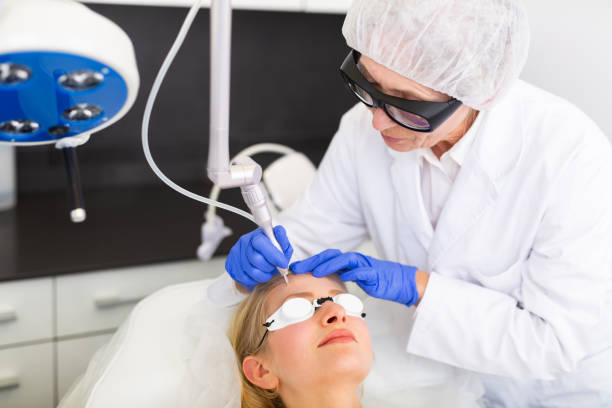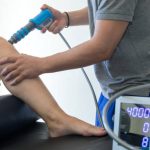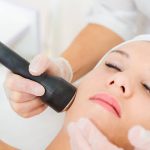Introduction
Acne vulgaris is a skin disease of the pilosebaceous unit that is linked to psychosocial comorbidities. Many oral and topical treatments treat acne, including antimicrobials, antibacterials, and Retinoids. Conventional acne treatments may be long-lasting and accompanied by adverse effects. This has led to a search for better options. Acne tends to improve after exposure to sunlight. This has led to the creation of lasers and other treatments using light over 20 years. Lasers and light sources can be administered together with topical and oral therapies or as an alternative treatment. To date, tests using light sources and lasers have been limited, and the results could be more consistent. This article reviews the latest developments concerning using lasers and light therapy for treating acne vulgaris.
Pathogenesis of Acne
Acne is an ongoing inflammatory disorder of the pilosebaceous unit, and the main factors in the pathogenesis of acne are an increase in sebum production and over-cornification and hyperplasia of the pilosebaceous gland and a change in the microbial flora, mainly colonization of the ducts by Propionibacterium acnes (P. acnes) and inflammation. Recent clinical and molecular biology studies provide a new understanding of topics like sebocyte biology, the role of androgens hyperkeratinization [2], dietary triggers, and the impact of cytokines and toll-like receptors leading to the discovery of new targets for acne treatment.
Treatment using Laser or Light Based Therapies
Lasers and light-based devices could be an alternative to traditional treatment for acne in some patients, like non-responders or those who have not responded, or patients with resistance to antibiotics. In the past century, various types of light sources were developed to treat or reduce the symptoms of acne. They include halogen, fluorescent lamps, xenon, tungsten, and lasers. The equipment used to treat acne is divided into categories based on the method of treatment, which includes devices that either directly or indirectly affect the P. acne are UVA/UVB and blue light as well as red and blue light combinations and equipment that affect the structure of sebaceous glands include aminolevulinic acids (ALA) as well as photodynamic therapy (PDT) and infrared lasers, radiofrequency, as well as devices that act on both Pulse dye laser (PDL) as well as potassium titanyl-phosphate (KTP) laser targets and intensified Pulsed Light (IPL).
Targeting P. Acnes
P. acnes, which is involved in the genesis of acne, is microaerophilic, gram-positive skin bacteria. As part of its normal reproductive and metabolic processes, it creates and stores endogenous porphyrins, specifically protoporphyrin, uroporphyrin, and coproporphyrin. 7 The porphyrins are receptive to light in the ultraviolet (UV) or blue light spectrum. The exposure to light wavelengths that absorb causes these photosensitizers, which in turn produce highly reactive free radicals that then trigger the destruction of bacteria. The singlet oxygen produced during the reaction is a powerful antioxidant that can destroy lipids within the cell wall P. acnes. 10 Absorption and photodynamic excitations are most efficient between wavelengths between 400 and 430nm range if you have sufficient illumination; the process could begin with a range of wavelengths. Numerous light sources can cause P. acnes, including the narrowband sources of light, IPL devices (broadband light), KTP lasers (532 nm) PDLs (585-595 nm), and a variety of red/orange light sources, also known as light lasers (610-635 nm) because these light sources possess wavelengths that are similar to the absorption peak for P. acnes porphyrins.
UVA/UVB
75% of people experience improvements in their acne after exposure to sunlight [11The majority of patients report improvement in their acne after exposure to sunlight. However, it wasn’t clear until recently what wavelengths contributed to this positive effect: UV, visible light, or a mix of them. UVA or UVB treatment has been found to have a minor beneficial effect but may cause cancer.
Blue Light and Red Light
Blue light is the highest efficiency in visible wavelength for activating the endogenous porphyrin components of P. acnes because the 407-420-nm band has the highest photoexcitation coefficient for porphyrin.
However, blue light has a low deep skin penetration. 10 The red light, however, is also known for its greater penetration to the sebaceous glands [13and [13] and could possess anti-inflammatory properties by influencing cytokine release from macrophages. Research has proven, based on in vitro experiments, that the effectiveness of P. acnes is inversely related to light intensity. By an activity spectrum that explains the activation of P. acnes, the sensibility of P. acnes is the highest at shorter wavelengths and decreases as wavelength increases. [15]
Numerous studies demonstrate the effectiveness of blue light and the combination of red and blue light for treating moderate to mild acne [Table 2. The majority of studies were conducted in open-label, with sample sizes ranging from 30-50 patients. The results consistently showed an improvement in the inflammation lesions using blue light. Furthermore, the studies reported results from follow-up within 12 weeks following treatment. Acne clearing can vary for patients, and relapse rates are very high when treatment is stopped. We have quoted two studies of a combination of blue-red light therapy and one of them shows that a combination is superior to blue light alone.
Lasers:
KTP
The 532 Nm green laser pulse therapy is being tested since it penetrates further than blue light and activates porphyrins to treat P. acnes. It is well-tolerated and does not cause any specific collateral thermal damage to the sebaceous glands. KTP has been proven effective in decreasing acne severity, with no adverse effects, according to Baugh and colleagues., [2525 during a study examined 26 subjects who had moderate acne on their faces. They concluded that using KTP KTP 532nm light source in treating acne vulgaris was secure and efficient, with results that lasted for up to four weeks following treatment.
Another prospective and split-face-based study, with 11 patients treated with KTP laser, conducted by Bowes and co., showed a 36% reduction in mild to moderate acne lesions compared to the 2% increase observed within the control group following one month. A decrease of 28% in sebum production but a minimal impact on P. acnes (measured through fluorescent imaging) was also found. [26]
Yilmaz and co. Conducted another study, [27The] by Yilmaz et al. [27] to assess the effectiveness and safety of the laser 532-nm KTP and evaluate the effect of twice weekly and one-time treatments for mild-to moderately alopecia vulgaris was conducted with 38 patients. They concluded that the 532-nm laser therapy could be a viable alternative treatment option for specific acne vulgaris patients, with little difference in results between weekly and once-a-week treatments.
PDL
585-nm PDL, which targets oxyhemoglobin, has also been researched for treating acne. It triggers selective photothermolysis of the dilated vascular component that causes acne-related inflammation. By delivering the coherent light of yellow, pores get activated and produce phototoxic effects.
Seaton and colleagues., [28 28. showed a reduction of 49% in the number of inflammatory lesions compared to 10% in control subjects 12 weeks following treatment with 585nm PD. Compared to the controls, nearly 50% of the patients treated (regardless of their severity at the beginning) saw a reduction of 50% in the number of lesion cells after 12 weeks. In a masked, placebo-controlled trial of 26 patients suffering from moderate-to-moderate acne, Orringer, and colleagues., [2929 observed an improvement trend by the side treated with laser, but it wasn’t statistically meaningful.
Seaton and colleagues conducted another study. [30] using a laser pulsed with dye did not affect the extent of P. acnes colonization or sebum production according to the absorbent tape’s standard use. The study revealed an upregulation of transforming growth factor b, a potent stimulator of neocollagenesis and a potent inhibiter of inflammation. The effectiveness of this laser in treating inflammatory acne could be due to its local anti-inflammatory properties.




